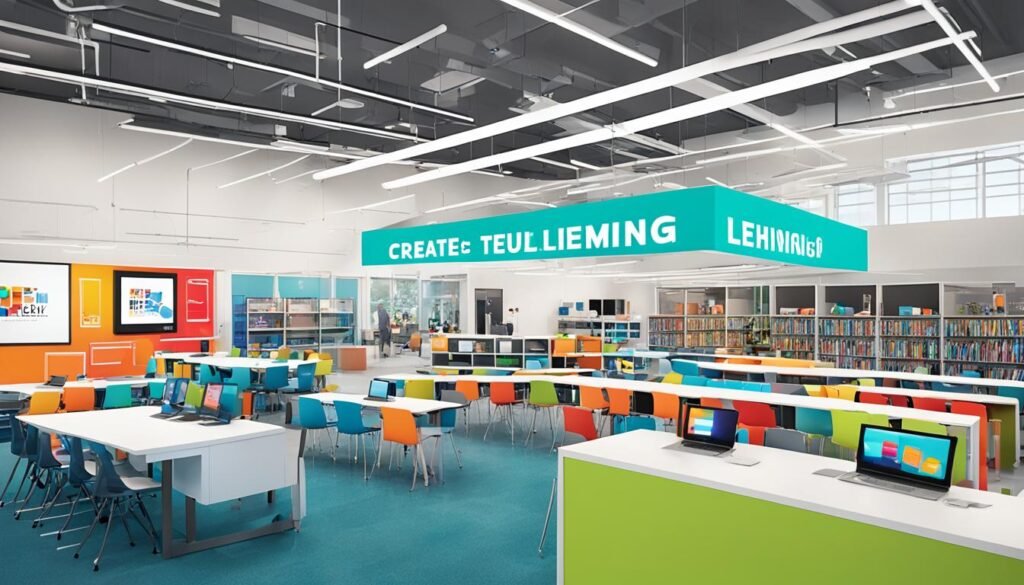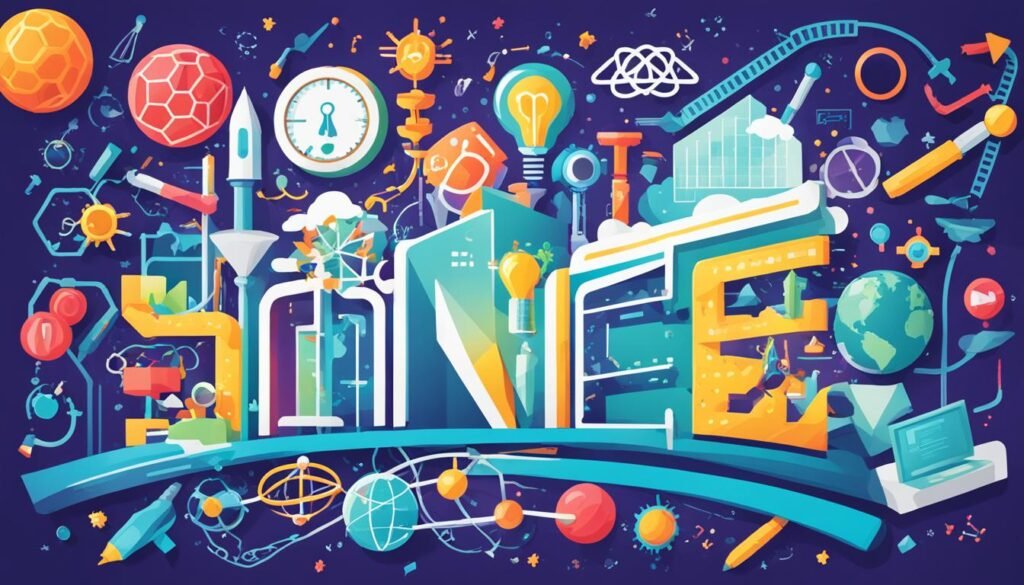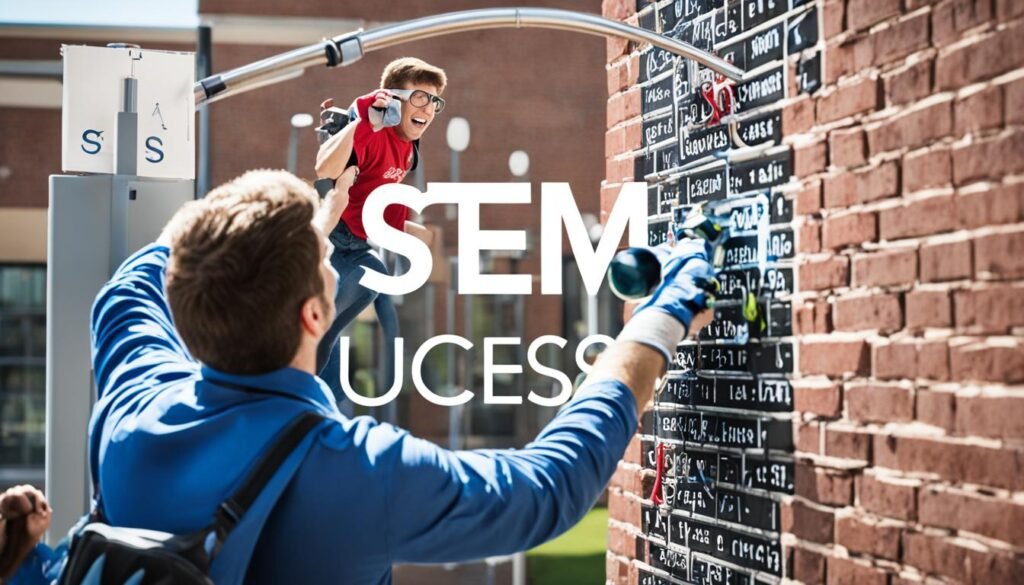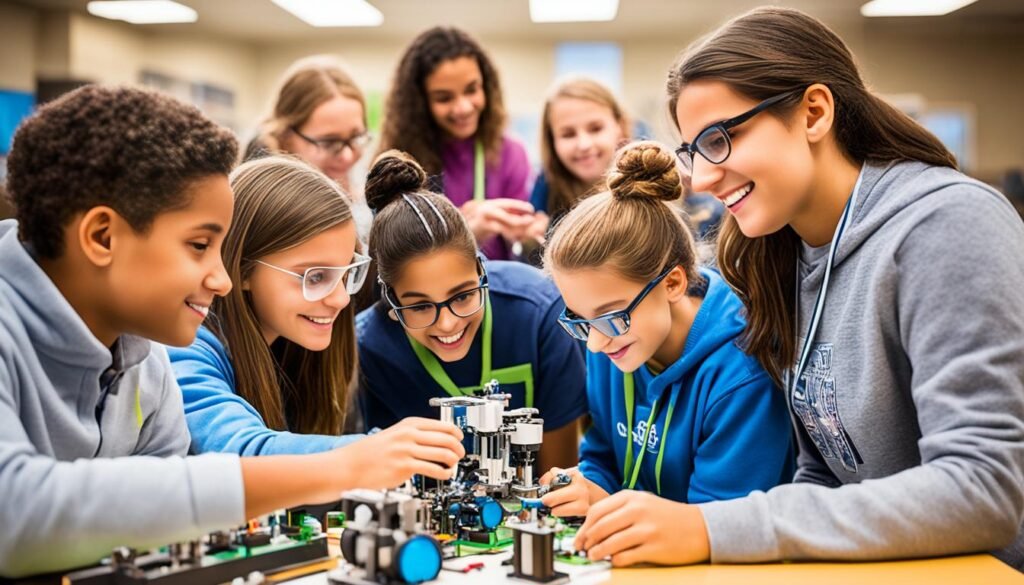STEM Learning Materials is a transformative approach to learning that fosters critical thinking, problem-solving, and creativity through the integration of science, technology, engineering, and mathematics. By incorporating STEM into the curriculum, students are equipped with the skills and knowledge needed to thrive in the modern world.
One key aspect of STEM education is the use of hands-on educational experiences, such as interactive experiments and engaging projects, that allow students to explore math and science concepts in a practical and meaningful way. These experiences not only deepen students’ understanding but also foster a love for these subjects.
In recent years, there has been a shift towards online resources and collaborative platforms, making STEM learning materials more accessible than ever before. Students can now engage in STEM activities anytime, anywhere, through web-based resources and interactive apps. Additionally, the transformation of libraries into Learning Resource Centers has further enriched STEM learning, providing students with a wealth of resources and support.
The importance of a STEM mindset cannot be overstated. It encourages fundamental understanding, problem-solving skills, critical thinking, and STEM literacy, all of which are essential for success in the modern world. By integrating STEM into classrooms and providing students with engaging learning experiences, we can prepare them for the jobs of the future and spark their curiosity and passion for lifelong learning.
Key Takeaways:
- STEM education fosters critical thinking, problem-solving, and creativity.
- Hands-on educational experiences enhance students’ understanding and love for math and science.
- Online resources and collaborative platforms make STEM learning materials accessible anytime, anywhere.
- The STEM mindset encourages fundamental understanding, problem-solving, critical thinking, and STEM literacy.
- Integrating STEM into classrooms prepares students for the future and sparks curiosity and passion for lifelong learning.
Benefits of STEM Learning Resources
STEM learning resources offer a wealth of advantages for both students and educators. These resources encompass a wide range of educational materials, including hands-on activities, STEM kits, science experiments, engineering projects, and math games. By utilizing these resources, students are exposed to inquiry-based learning approaches, enabling them to explore and create while integrating various STEM topics. Furthermore, the abundance of high-quality STEM learning materials ignites students’ interest in STEM subjects, fostering engagement and curiosity.
One of the primary benefits of STEM resources is their ability to provide interactive learning experiences, promoting problem-solving skills and critical thinking. Through hands-on activities and experiments, students actively engage with STEM concepts, deepening their understanding and knowledge. These resources also support educators and parents in effectively teaching STEM concepts, offering valuable instructional support and presenting new ideas for lesson plans and activities.
By incorporating STEM learning resources into educational settings, students gain exposure to practical applications of STEM subjects, helping them understand how these disciplines are relevant to their lives. This dynamic approach sparks creativity and innovation, empowering students to become active participants in their own learning. Additionally, by integrating STEM learning resources, educators can create an inclusive and engaging classroom environment, catering to diverse learning styles and needs.
STEM learning resources provide hands-on activities, experiments, and interactive materials that engage students in problem-solving and critical thinking. These resources support educators, promoting effective teaching strategies and presenting exciting ideas for lesson plans and activities.
The Benefits of STEM Learning Resources at a Glance:
- Promote inquiry-based learning
- Integrate STEM topics
- Foster exploration and creativity
- Engage students in hands-on activities
- Spark interest in STEM subjects
- Encourage interactive and problem-based learning
- Support effective STEM teaching for educators and parents
An Example of STEM Learning Resource:
One prominent STEM learning resource is the Osmo Genius Starter Kit, which combines digital gameplay with physical manipulatives. This kit allows students to experiment with math, science, art, and more, providing interactive and immersive learning experiences. With hands-on activities, students can develop problem-solving skills and logical reasoning while having fun.
| STEM Learning Resource | Description |
|---|---|
| Osmo Genius Starter Kit | Combines digital gameplay with physical manipulatives to provide interactive and immersive STEM learning experiences. |
| LittleBits Electronics STEM Starter Kit | Enables students to explore electronics and engineering through a variety of hands-on projects, promoting creativity and problem-solving skills. |
| K’NEX Education – Intro to Structures: Bridges | Offers a hands-on approach to engineering and construction by allowing students to design and build their own bridge models. |
| Sphero SPRK+ | Engages students in coding and robotics, encouraging creativity and critical thinking through hands-on programming activities. |
Importance of STEM Resources for Teachers and Students
STEM resources are invaluable tools that contribute to the success of teachers and students in STEM education. These resources provide a wide range of instructional materials, lesson plans, and activities focused on STEM concepts. With their comprehensive content covering various STEM topics such as math, science, engineering, and technology, STEM resources empower teachers to integrate STEM seamlessly into their classrooms.
By utilizing STEM resources, teachers make learning more engaging and relevant for students. These resources offer hands-on experiences, problem-solving challenges, and interactive experiments that captivate students’ interest and stimulate their curiosity. STEM resources foster a deeper understanding of STEM concepts while promoting critical thinking, collaboration, and creativity.
Furthermore, STEM resources are not limited to the classroom; they also extend to parents and families. These resources provide support and guidance for parents to actively participate in their children’s STEM education at home. By equipping parents with the necessary tools and knowledge, STEM resources create a collaborative learning environment that enhances student achievement and engagement.
Overall, the presence of STEM resources is vital in the educational landscape. They contribute to the development of essential STEM skills, provide learning opportunities for students, and bridge the gap between classroom and real-world applications. STEM resources empower educators and parents to nurture a new generation of scientifically literate individuals who are well-prepared for the challenges and opportunities of the future.
STEM Learning Resources: Online Platforms and Apps
The advancement of technology has revolutionized the way we access educational resources, and STEM education is no exception. Online platforms and apps have emerged as valuable tools for providing STEM learning materials, offering a wide range of web-based resources, interactive learning activities, and technology tools.
These platforms and apps serve as virtual hubs for students to explore various STEM topics, conduct virtual experiments, and engage in coding and programming activities. With just a few clicks, students can access a wealth of interactive learning resources that enhance their understanding of STEM concepts.
img src=”https://seowriting.ai/32_6.png” alt=”STEM Learning Resources” align=”center”
These online platforms and apps provide flexible and accessible learning experiences, eliminating the constraints of time and location. Students can engage in STEM education anytime, anywhere, allowing for personalized and self-paced learning. Whether in the classroom or at home, students can delve into interactive learning resources that cater to their individual interests and learning styles.
Through these platforms and apps, students can immerse themselves in hands-on activities, virtual simulations, and experiments that bring STEM concepts to life. They can collaborate with peers, participate in online forums, and even showcase their own projects, fostering a sense of community and engagement in the learning process.
Benefits of Online STEM Platforms and Apps:
- Access to a wide range of web-based materials
- Interactive learning activities and simulations
- Opportunities for coding and programming
- Flexible and personalized learning experiences
- Enhanced engagement and motivation
- Community-building and collaboration
Online platforms and apps have transformed STEM education, making it more interactive, engaging, and accessible than ever before. They provide students with the tools and resources they need to develop essential STEM skills and foster a lifelong love for learning in STEM fields.
These online platforms and apps allow students to explore STEM topics, conduct virtual experiments, and engage in coding and programming activities, making STEM education accessible to students anytime, anywhere.
By embracing these web-based resources and technology tools, educators can unlock new possibilities in STEM instruction, enhancing the learning experience and preparing students for the challenges of the future.
The Role of O’Reilly for Higher Education in STEM Learning
O’Reilly for Higher Education is a comprehensive platform that provides a wealth of resources for STEM learning. With over 60,000 titles, including books, audiobooks, videos, courses, and case studies, O’Reilly offers a wide range of materials to support students and educators in the STEM field.
By accessing O’Reilly’s vast collection, learners can explore various STEM subjects and discover new concepts and ideas. Whether it’s reading, listening, or visual learning, O’Reilly caters to different learning preferences, ensuring an engaging and personalized learning experience.
One of the unique features of O’Reilly for Higher Education is its customizable playlists and real-time personalized recommendations. Users can create playlists according to their interests and learning goals, allowing them to structure their STEM learning experience.
Highlighted Resources
“The O’Reilly platform has been instrumental in my STEM journey. The wide range of resources available has helped me explore different topics and deepen my understanding of key concepts. The personalized recommendations have also provided me with tailored content that aligns with my interests. O’Reilly has truly enhanced my STEM learning experience.”
– Emily Johnson, STEM Student
With O’Reilly’s focus on curated content from top innovators, users can rest assured that they are accessing high-quality resources. The platform features materials from experts in their respective fields, offering enriching and well-guided learning experiences.
Whether you are a student, educator, or lifelong learner, O’Reilly for Higher Education provides the necessary resources to support your STEM journey. With its vast collection and personalized recommendations, O’Reilly is committed to enhancing the learning experience and fostering STEM literacy.

| Benefits of O’Reilly for Higher Education in STEM Learning |
|---|
| Access to over 60,000 STEM titles |
| Diverse range of formats including books, audiobooks, videos, and courses |
| Customizable playlists and real-time personalized recommendations |
| Curated content from top innovators |
Gateways to STEM: Opportunities and Challenges
Gateways to STEM present both opportunities and challenges for students’ progression in STEM education and future careers. These gateways enable students to develop valuable skills in logical thinking, problem-solving, and troubleshooting that are highly sought after in STEM fields. However, navigating these gateways can also pose challenges, including the lack of clearly defined pathways and disparities in STEM preparation.
One of the primary challenges in STEM education is defining high-quality, flexible pathways within K-12 education. The term STEM encompasses a wide range of disciplines, making it complex to establish standardized definitions and guidelines. This lack of clarity can affect students’ understanding of the necessary skills and knowledge required for STEM careers.
Additionally, there are disparities in STEM preparation across different communities and educational institutions. Some students may have limited access to quality STEM resources and opportunities, which can create barriers to their STEM education and career advancement.
In order to address these opportunities and challenges, it is crucial to establish clearer definitions and preparation guidelines for STEM education. This will provide students with a more comprehensive understanding of the skills needed for STEM careers, enabling them to make informed decisions about their educational pathways.
Furthermore, equitable access to STEM education and careers must be a priority. Initiatives should focus on providing resources and support to underserved communities, bridging the gap in STEM preparation and opportunities.
The Importance of Clear Definitions and Preparation Guidelines

| Opportunities | Challenges |
|---|---|
|
|
Establishing clearer definitions and preparation guidelines for STEM education can help students make informed decisions about their educational pathways. This will ensure that they acquire the necessary skills and knowledge to succeed in STEM careers.
Focusing on equitable access to STEM education and careers is equally important. Providing resources and support to underserved communities will help bridge the gap in STEM preparation and opportunities, creating a more inclusive and diverse STEM workforce.
Addressing the Barriers to Success in STEM Education
Several barriers hinder success in STEM education, particularly for disadvantaged students. These barriers include a lack of STEM preparation, limited access to STEM resources, and disparities in STEM skills development.
One of the significant barriers is the inadequacy of remedial math education and course sequences that do not provide clear pathways to high-paying and satisfying careers in STEM fields. This limits the opportunities for students and prevents them from fully exploring their potential in STEM.
Moreover, the definitions of STEM jobs often differ, making it challenging to determine the necessary preparation for success in STEM careers. This lack of clarity creates confusion among students and hinders their ability to plan and pursue appropriate STEM pathways.
Elementary teachers also face barriers in teaching science and math effectively, as many feel less confident in these subjects. This lack of confidence could impede students’ early experiences in science and math, preventing them from developing a strong foundation in STEM skills.
To address these barriers, collaborative efforts between industries, K-12 leaders, and the education community are crucial. These partnerships can bridge the gap by introducing advanced technologies, improving STEM curriculum and resources, and providing professional development opportunities for teachers.
Additionally, reimagining gateway classes, such as statistics, can offer new pathways to STEM success. By expanding the scope of gateway classes and incorporating relevant STEM skills, students can access alternative avenues to pursue their interests in STEM fields.
Collaborative efforts between industries, K-12 leaders, and the education community are crucial in addressing the barriers to success in STEM education.
Barriers to Success in STEM Education
| Barriers | Description |
|---|---|
| Lack of STEM preparation | Inadequate math education and unclear career pathways |
| Limited access to STEM | Disparities in resources and opportunities |
| Disparities in STEM skills | Differences in STEM skill development among students |
Addressing these barriers is crucial to ensure that all students have equal opportunities to succeed in STEM education. By providing comprehensive STEM preparation, equitable access to resources, and continuous support, we can create a more inclusive and diverse STEM community.

Building a Strong Foundation in STEM Education
Building a strong foundation in STEM education is crucial for preparing students for the future. Early experiences in science and math lay the groundwork for a lifelong interest and proficiency in STEM subjects. Elementary teachers play a vital role in providing these early STEM experiences, shaping students’ curiosity and passion for learning. To ensure effective STEM instruction, educators should receive support and training that enhances their STEM teaching skills.
Partnerships between industries and schools can greatly contribute to building a strong foundation in STEM education. These collaborations introduce advanced technologies and real-world applications of STEM concepts into the learning environment, sparking students’ interest and showing them the practical value of STEM skills. By bridging the gap between the classroom and the industry, these partnerships make STEM education more relevant and engaging.
High school curriculum plays a significant role in establishing a strong foundation in STEM education. It should include rigorous pathways that provide students with the necessary knowledge and skills for pursuing STEM careers. Emphasizing essential skills like problem-solving, critical thinking, and collaboration prepares students to excel in the dynamic and challenging field of STEM.
Redefining gateway classes can also contribute to building a strong foundation in STEM. Traditionally, gateway classes like algebra have been considered pivotal for success in STEM fields. However, introducing additional gateways, such as statistics, can create alternative routes for students to excel in STEM subjects. By broadening the range of gateway classes, more students can discover their passion and aptitude for STEM.
Addressing disparities in access to STEM education and persistence in STEM careers is essential for building a strong foundation. Every student, regardless of their background or circumstances, deserves equal opportunities to engage in STEM learning. By focusing on equity and inclusivity, we can ensure that all students have the chance to develop strong STEM skills and pursue rewarding careers.

Ultimately, building a strong foundation in STEM education sets the stage for students’ success in the modern world. By providing early STEM experiences, fostering partnerships with industries, designing inclusive curriculum, and addressing disparities, we can create a solid pathway for students to develop their STEM skills and thrive in the STEM fields of tomorrow.
Also Read:- Unlocking Opportunities: Petroleum Engineering Certifications Explained
Conclusion
Integrating STEM learning materials into classrooms is crucial for preparing students for the future. STEM education offers engaging and relevant learning experiences that foster the development of reasoning, teamwork, investigative, and creative skills. By using a variety of STEM resources, including online platforms, apps, and curated collections, educators can enhance the learning process and promote STEM literacy among students.
Collaborative efforts and partnerships among educators, industries, and parents play a significant role in building a strong foundation in STEM education. By working together, they can create an environment that supports and nurtures students’ interest in STEM subjects. By addressing barriers to success and reimagining gateways to STEM, equitable access and opportunities for all students can be provided.
STEM education is all about preparing students for the future by fostering critical thinking, problem-solving, and innovative mindset. Through engaging learning experiences and the use of STEM learning materials, students can develop the necessary skills to thrive in the ever-evolving world. By investing in STEM education today, we are empowering the next generation to be leaders and contributors in the fields of science, technology, engineering, and mathematics.
FAQs
Q: What is STEM education?
A: STEM education focuses on the subjects of science, technology, engineering, and mathematics, providing students with a hands-on learning approach that encourages exploration and problem-solving.
Q: Where can I find STEM learning resources?
A: You can find STEM learning resources online through websites like PBS, which offer a wide variety of materials and lesson plans for educators national science .
Q: How can STEM materials be integrated into the classroom?
A: STEM materials can be integrated into the classroom by incorporating hands-on activities, experiments, and projects that align with STEM topics and concepts scratch .
Q: What are some examples of STEM classroom supplies?
A: STEM classroom supplies can include kits for coding, robotics, engineering, mathematics manipulatives, and other resources that support hands-on learning experiences resources related.
Q: How can STEM learning resources be used to engage students?
A: STEM learning resources can be used to engage students by providing real-world applications, encouraging inquiry-based learning, and fostering a collaborative and interactive classroom setting stem lesson.
Q: How can educators encourage STEM exploration in their classrooms?
A: Educators can encourage STEM exploration by setting up opportunities for students to explore STEM concepts through experimentation, problem-solving, and project-based learning activities classroom learning .
Q: Are there resources available to help parents teach STEM concepts at home?
A: Yes, there are resources available for parents to teach STEM concepts at home, including online platforms offering STEM-related activities, lessons, and experiments that parents can do with their children.
Source Links
- https://www.linkedin.com/pulse/unlocking-power-stem-learning-todays-classrooms-murtaza-sinnarwala-s3ilf?trk=public_post_main-feed-card_feed-article-content
- https://www.essex.ac.uk/blog/posts/2024/01/04/stem-learning-with-oreilly-for-higher-education
- https://www.edweek.org/teaching-learning/unlocking-stem-pathways-for-all-students/2018/05

